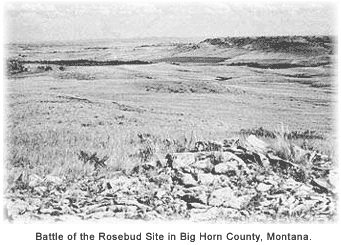Given the number of combatants, the Battle of the Rosebud was one of the largest confrontations waged in the Indian Wars.
In the spring of 1876, the U.S. Army took to the field against the Lakota (Sioux) and Cheyenne. The tribes had not met an ultimatum to return to their reservations in the Dakotas and Nebraska after U.S. negotiations to acquire the sacred Black Hills had failed in the fall of 1875.
 Brigadier General George Crook moved 1,050 soldiers and 260 Crow and Shoshone scouts north into the Rosebud Valley, Montana Territory, after his scouts reported a significant concentration of Lakota and Cheyenne there. Crook’s column represented one of three tactical columns placed in the field in the summer to ferret out the natives.
On June 17, a roughly equal number of warriors led by Crazy Horse assaulted Crook's force along Rosebud Creek. The confused battle over uneven ground separated into three pitched skirmishes. There were numerous brave acts on both sides, including a Cheyenne girl who rescued her brother after his horse had been shot out from under him.*
After six hours and much lead shot, the Lakotas and Cheyennes called off the fight; the braves had fought Crook’s men to a standstill. Crook's force suffered 10 killed and 21 wounded, and the warriors sustained similar casualties. Crook claimed the day because he believed he had driven the Indians from the field, but his claim was empty.
The fight was at most a stalemate, and Crook's badly hit column withdrew to its base camp on Goose Creek near present-day Sheridan, Wyoming. As a result of the battle, one of the three army columns converging on the Indians was effectively incapacitated and taken out of the campaign for two months.
Some say the battle set the stage for the Indian victory involving many of the same warriors eight days later and 30 miles away, at the Battle of the Little Bighorn. At least partial blame has been laid at Crook's feet for Custer's disaster because the latter failed to rout the Indians, give chase, and conceivably force them north into other U.S. Army columns. Instead, the reasoning goes, the action gave the Lakota and Cheyenne a psychological boost.
But other scholars say Crook is wrongfully implicated in Custer's demise: The former had barely enough provisions for his soldiers through June 18, which suggests he would have had to reverse course the following day. In addition, Crook could not have advised General Terry, Custer's commanding officer, of the battle's outcome soon enough to aid Custer.
To historians of the battle as well as Native Americans today, the Rosebud is acknowledged as a positive chapter in the Lakota and Cheyenne defense of their lands and lifeways.
However, it was not a simple fight between whites and Indians. To the Crows and Shoshones who scouted for the Americans, it was their battle too, against the Lakotas and Cheyennes who were encroaching on their lands and lifeways.
Brigadier General George Crook moved 1,050 soldiers and 260 Crow and Shoshone scouts north into the Rosebud Valley, Montana Territory, after his scouts reported a significant concentration of Lakota and Cheyenne there. Crook’s column represented one of three tactical columns placed in the field in the summer to ferret out the natives.
On June 17, a roughly equal number of warriors led by Crazy Horse assaulted Crook's force along Rosebud Creek. The confused battle over uneven ground separated into three pitched skirmishes. There were numerous brave acts on both sides, including a Cheyenne girl who rescued her brother after his horse had been shot out from under him.*
After six hours and much lead shot, the Lakotas and Cheyennes called off the fight; the braves had fought Crook’s men to a standstill. Crook's force suffered 10 killed and 21 wounded, and the warriors sustained similar casualties. Crook claimed the day because he believed he had driven the Indians from the field, but his claim was empty.
The fight was at most a stalemate, and Crook's badly hit column withdrew to its base camp on Goose Creek near present-day Sheridan, Wyoming. As a result of the battle, one of the three army columns converging on the Indians was effectively incapacitated and taken out of the campaign for two months.
Some say the battle set the stage for the Indian victory involving many of the same warriors eight days later and 30 miles away, at the Battle of the Little Bighorn. At least partial blame has been laid at Crook's feet for Custer's disaster because the latter failed to rout the Indians, give chase, and conceivably force them north into other U.S. Army columns. Instead, the reasoning goes, the action gave the Lakota and Cheyenne a psychological boost.
But other scholars say Crook is wrongfully implicated in Custer's demise: The former had barely enough provisions for his soldiers through June 18, which suggests he would have had to reverse course the following day. In addition, Crook could not have advised General Terry, Custer's commanding officer, of the battle's outcome soon enough to aid Custer.
To historians of the battle as well as Native Americans today, the Rosebud is acknowledged as a positive chapter in the Lakota and Cheyenne defense of their lands and lifeways.
However, it was not a simple fight between whites and Indians. To the Crows and Shoshones who scouted for the Americans, it was their battle too, against the Lakotas and Cheyennes who were encroaching on their lands and lifeways.